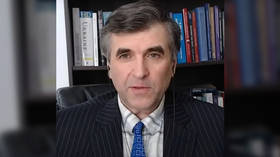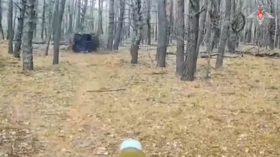ROAR: “Peaceful military doctrine according to present standards”

Russian President Dmitry Medvedev has signed the new Military Doctrine, which outlines the country’s military position and the principles of state nuclear deterrence policy for the next ten years.
The document has been adopted after an assessment of new threats and challenges faced by Russia. The new doctrine on the whole repeats the provisions of the previous one, adopted in 2000, which was “strictly defensive,”
observers say.
The main difference of the new document is that now “for the first time external military threats have been specified and the right to use armed forces abroad has been confirmed to defend the country’s interests and its citizens,” Rossiyskaya Gazeta daily said.
Also for the first time the main ally of Russia has been called in the doctrine, which stipulates that military and political cooperation with Belarus is a priority, the paper said.
The document says that the deployment of missile defense systems near the Russian border, as well as militarization of space and development of high-precision weapons presents a threat to the country.
According to the doctrine, the main tasks of the armed forces are: defense of the country’s sovereignty; its integrity and inviolability of territory; defense of citizens abroad from armed attacks; and fighting piracy, Vremya Novostey daily said.
The new military doctrine is, in fact, “a declaration about a state’s policy in the sphere of nuclear security, which is announced to the whole world,” the paper said.
Russia may now use nuclear weapons to response against an attack from a country possessing nuclear weapons or against an aggression against it or its allies if the existence of the state is threatened.
It is only natural, the paper said, because “now no state possessing nuclear weapons, rules out the possibility of its use.” Although Russia “does not consider any conflict acceptable, neither a nuclear nor a conventional one, the deterrent of them is the basis of the country’s military policy,” the paper said.
“We are not going to attack anyone, but we are not going to wait for the moment when a strike will be delivered on us,” the paper quoted Nikolay Patrushev, the Secretary of the Russian Security Council, as saying. Patrushev was one of the developers of the new doctrine, the daily noted.
According to the new doctrine, the armed forces should become more effective and mobile, with combined arms units performing different tasks. At the same time, the deputies of the parliament who participated in the preparation of the document failed to include the provision about the allocation of budget funds to purchase new arms, military equipment from foreign producers if Russia has no analogs, Gazeta.ru online newspaper said.
Analysts note that NATO’s attempts to expand the NATO military infrastructure closer to Russian borders and to give global functions to the alliance’s power potential were mentioned among the main military threats to Russia.
On the other hand, recently some analysts said that the new doctrine will determine Russia’s right to deliver a pre-emptive nuclear strike even in local military conflicts, but they were mistaken, Rossiyskaya Gazeta said.
Russia will not deliver pre-emptive nuclear strikes is case of threats to the state’s security and will use it only in case of an attack against it, Gazeta.ru online newspaper said. Some tougher provisions that had been proposed earlier were not included in the final variant, it noted. The 2000 doctrine said that Russia may use nuclear weapons in case of “a large-scale aggression with the use of nuclear weapons,” the paper added.
The doctrine was expected to be adopted in late October, and the wording about possible pre-emptive nuclear strike “provoked discussions,” the paper said. But the provision about the use of nuclear weapons that was included in the document “is rather mild,” believes Aleksey Arbatov, head of the Center for International Security at the Institute of World Economy and International Relations.
“I have seen all previous wordings, and this one is a very restrained and mild compared, even to the United States’ military doctrine,” he told Gazeta.ru. Although Russia retains the right to deliver a nuclear strike, there are so many conditions for this that, “according to the present standards, it could be described as a peaceful military doctrine,” Arbatov said.
According to the paper, the final variant of the doctrine does not contain the definition of aggression that was defined in the draft document as an illegal direct or indirect use of force by one state against sovereignty, territorial integrity or independence of another one.
Some “hawk generals” had allegedly proposed “to use nuclear weapons even in non-threatening situations,” Vremya Novostey said. But Deputy Prime Minister Sergey Ivanov called it “nonsense,” stressing that “Russian generals strictly follow political directives.”
The news doctrine does not differ from the previous one in the part regarding the hypothetical use of nuclear weapons, Ivanov told reporters at the Munich Security Conference. The conditions for the use of such weapons remain the same, Ivanov said.
Many analysts watching the situation in the sphere of nuclear weapons have the feeling that the new military doctrine “has become outdated immediately after its adoption,” Vremya Novostey said, explaining it by the quick change of the situation in the world.
In fact, the doctrine was approved the moment Romania revealed its decision to join the US missile defense program, which may affect the talks on a new strategic arms reduction treaty between Moscow and Washington, observers say. In his speech in Munich, Ivanov mentioned “the relationship between strategic offensive and strategic defensive arms.”
“One cannot seriously talk about reduction in nuclear capabilities if a nuclear state consistently develops and deploys systems aimed at providing its invulnerability to means of deterrence possessed by other states,” Ivanov said. He stressed that Russia “supports a broader international dialogue on AMD (antimissile defense) issues and has made a considerable contribution to global efforts aimed at reducing nuclear weapons.”
The provisions of the doctrine can be amended in accordance with the change of the character of dangers and threats, the tasks of ensuring security and defense, as well as the conditions of Russia’s development, Vremya Novostey said, citing officials of Russia’s Security Council.
While the military doctrine is an open document, the principles of state nuclear deterrence policy to 2020 may not be available, Vremya Novostey said. They describe the means of using nuclear weapons in different possible situations, “This is a kind of a plan of action in critical situations for the state,” the paper said.
Sergey Borisov, RT












